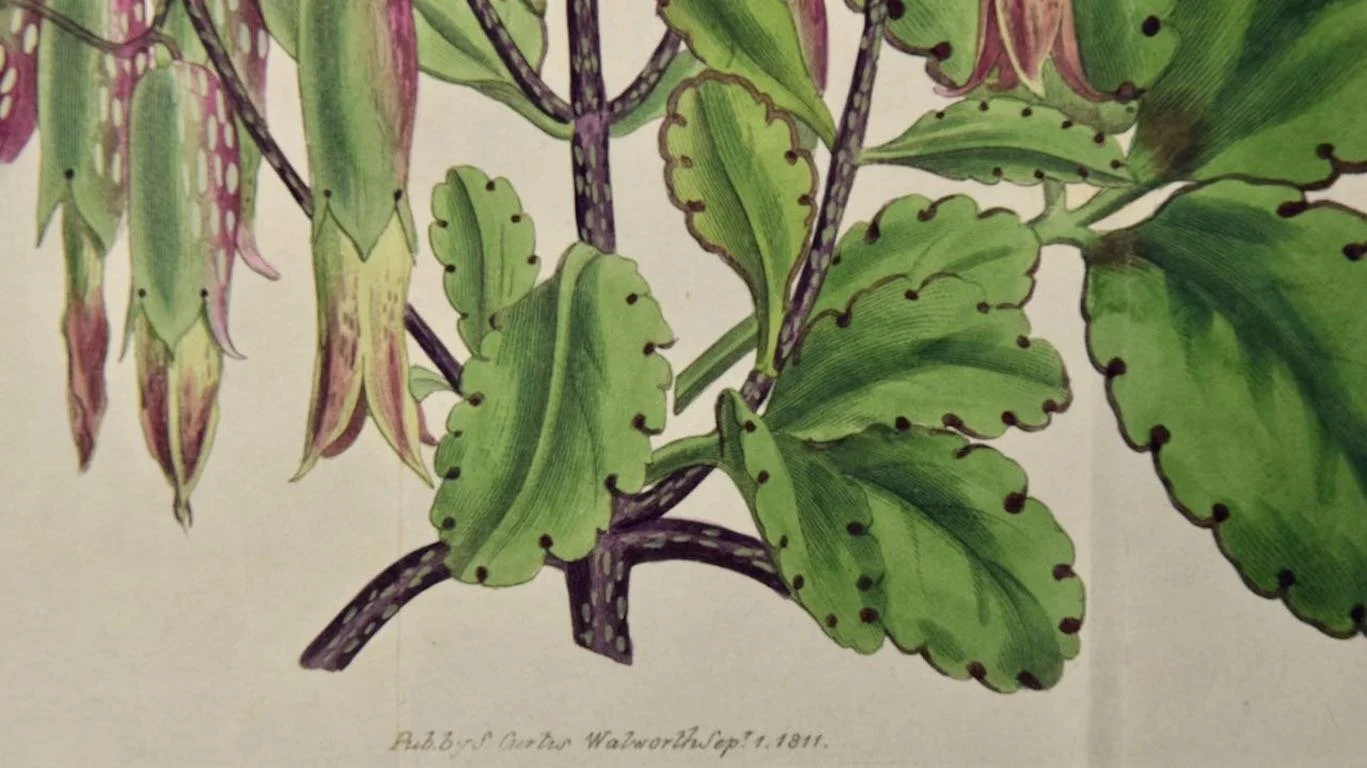Flowering Air Plant: A 19th Century Hand-colored Engraving by William Curtis
This early 19th century hand-colored double fold-out botanical engraving is entitled "Pendulous-flowered Bryophyllum", plate 1409, published in London in 1809 in William Curtis’s 'The Botanical Magazine, or Flower-Garden Displayed'. Bryophyllum pinnatum, also known as the air plant, is a well-recognized herb used in folk medicine. It is native to Madagascar and can be found in tropical and subtropical areas around the world. It is known for the profusion of miniature plantlets which arise from the margins of phylloclade.
Creator: William Curtis (1746 - 1799, American)
Creation Year: 1809
Dimensions: Height: 9 in (22.86 cm)
Width: 11.63 in (29.55 cm)
Medium: Engraving
Condition: See description below.
Reference #: 2308
This early 19th century hand-colored double fold-out botanical engraving is entitled "Pendulous-flowered Bryophyllum", plate 1409, published in London in 1809 in William Curtis’s 'The Botanical Magazine, or Flower-Garden Displayed'. Bryophyllum pinnatum, also known as the air plant, is a well-recognized herb used in folk medicine. It is native to Madagascar and can be found in tropical and subtropical areas around the world. It is known for the profusion of miniature plantlets which arise from the margins of phylloclade.
Creator: William Curtis (1746 - 1799, American)
Creation Year: 1809
Dimensions: Height: 9 in (22.86 cm)
Width: 11.63 in (29.55 cm)
Medium: Engraving
Condition: See description below.
Reference #: 2308
This early 19th century hand-colored double fold-out botanical engraving is entitled "Pendulous-flowered Bryophyllum", plate 1409, published in London in 1809 in William Curtis’s 'The Botanical Magazine, or Flower-Garden Displayed'. Bryophyllum pinnatum, also known as the air plant, is a well-recognized herb used in folk medicine. It is native to Madagascar and can be found in tropical and subtropical areas around the world. It is known for the profusion of miniature plantlets which arise from the margins of phylloclade.
Creator: William Curtis (1746 - 1799, American)
Creation Year: 1809
Dimensions: Height: 9 in (22.86 cm)
Width: 11.63 in (29.55 cm)
Medium: Engraving
Condition: See description below.
Reference #: 2308
This beautiful colorful and detailed botanical engraving has two vertical folds, as issued. The print measures 9" high by 11.63" wide. There is slight irregularity of the right edge of the sheet where it had been bound in the journal. The print is otherwise in excellent condition. The original English descriptive pages from the publication are included.
William Curtis (1746-1799) was an English botanist and entomologist. His first career was as an apothecary, but subsequently focussed on natural history. He became an author in his mid twenties, publishing a treatise on collecting and preserving insects. He worked as at the Chelsea Physic Garden from 1771 to 1777, but then established his own London Botanic Garden in 1779. He began publishing 'The Botanical Magazine; or Flower-Garden Displayed' an illustrated botanical publication, in 1787. It has become the longest published botanical magazine in history, still published currently. William Curtis was precise in his approach to the research and illustration of plants for the journal. Each illustration is done with attention to detail and color, using copperplate engraving and etching techniques and hand-coloring with watercolor paints. Each print is accompanied by an extensive textual description of the plant, including its scientific features.






























